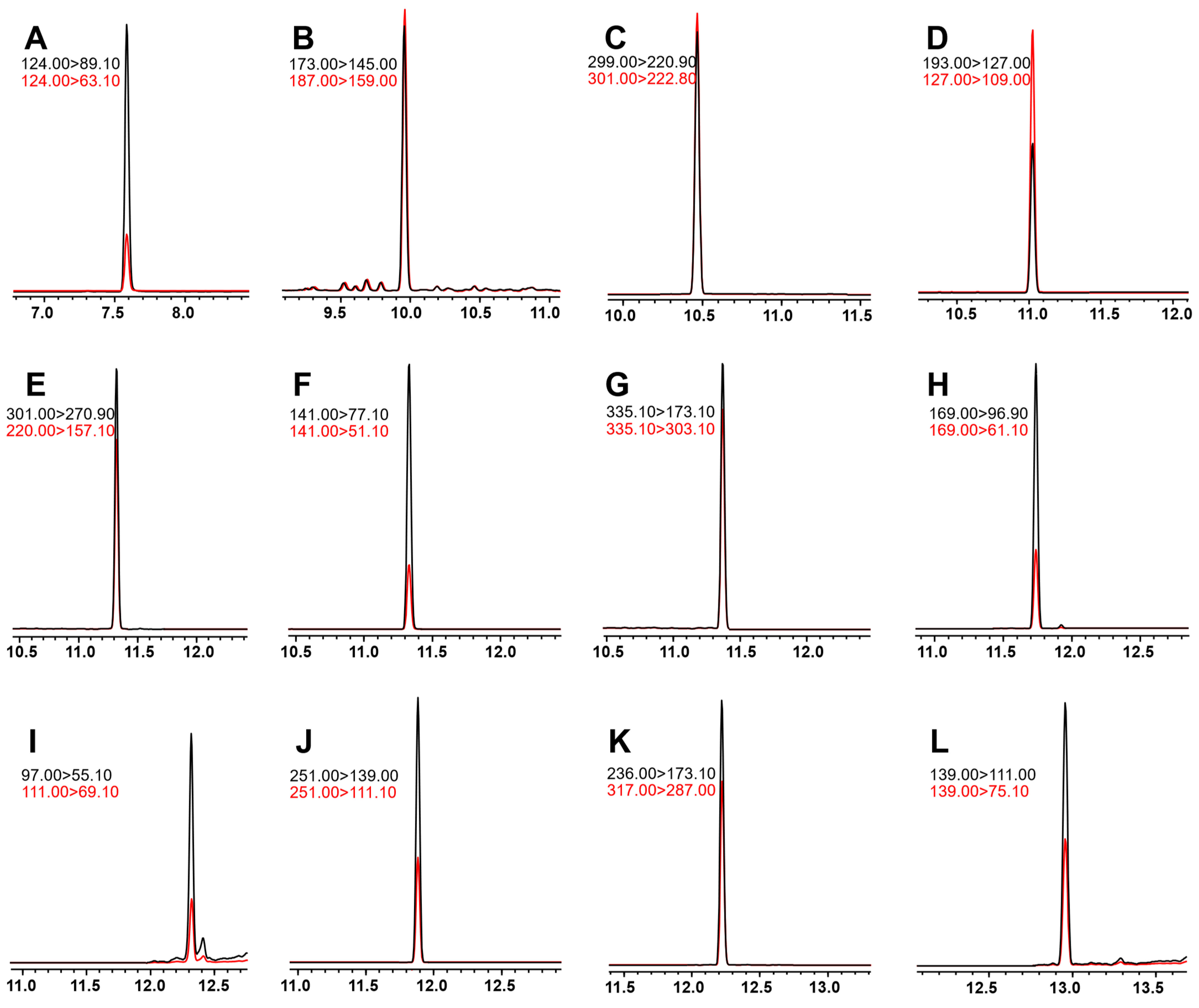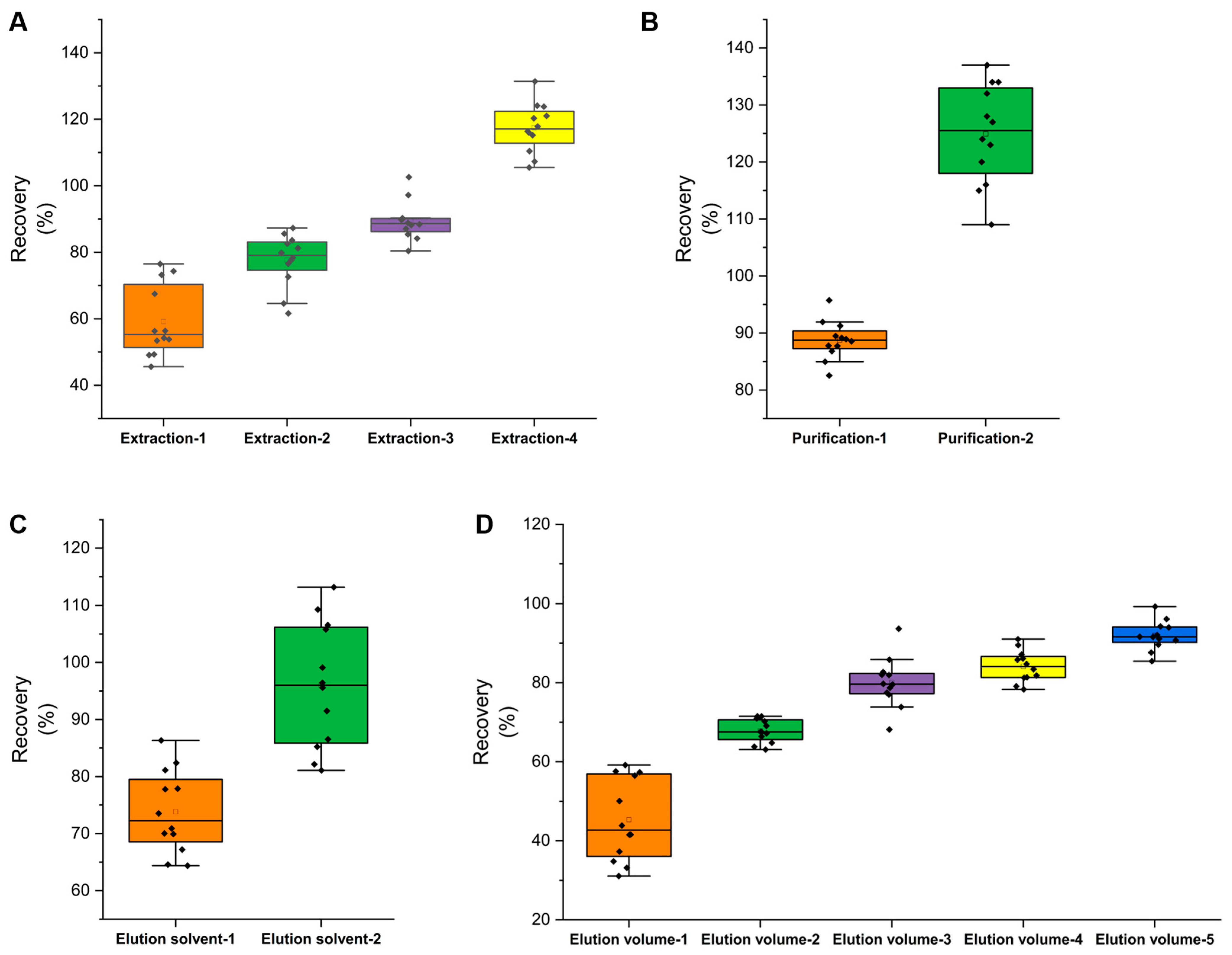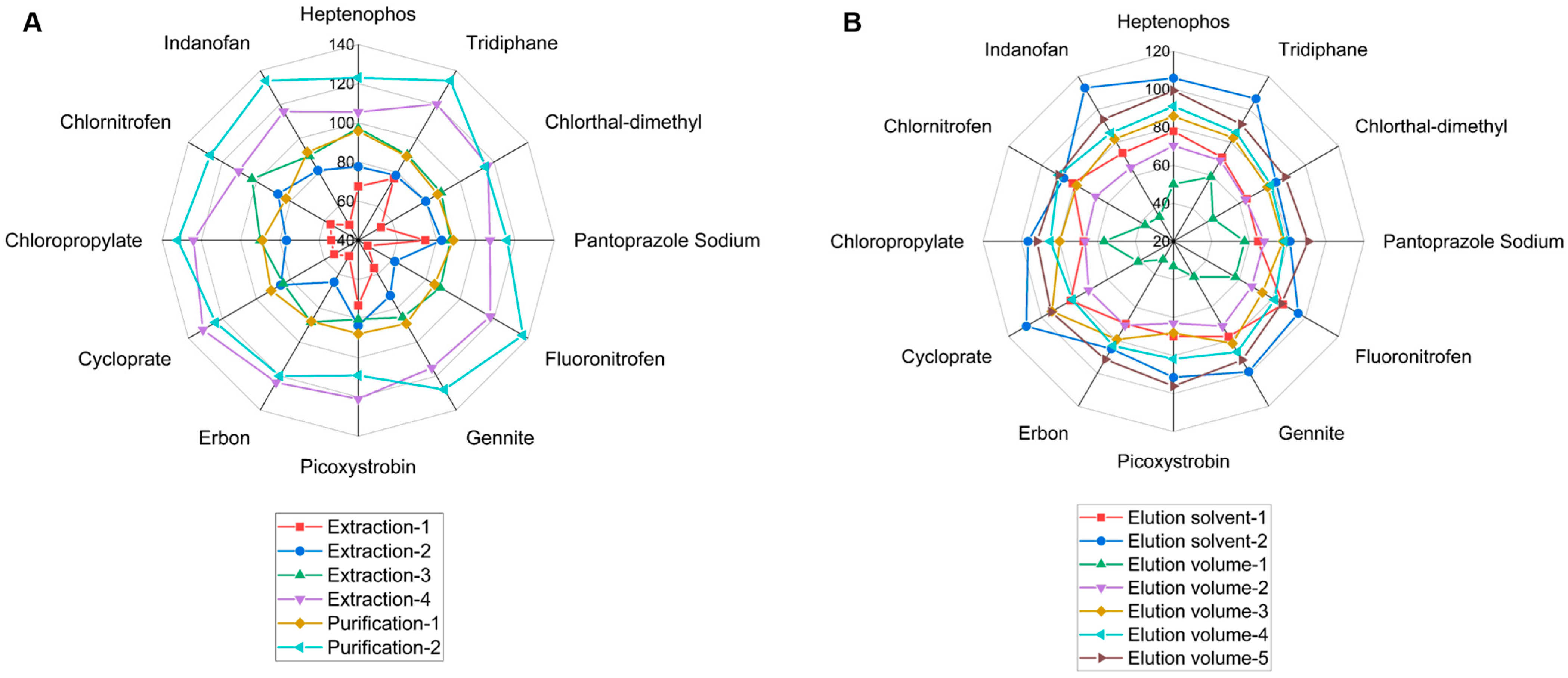Multiresidue Pesticide Analysis in Tea Using GC–MS/MS to Determine 12 Pesticide Residues (GB 2763-2021)
Abstract
:1. Introduction
2. Results and Discussion
2.1. Optimization of GC–MS/MS Condition
2.2. Optimization of Sample Preparation
2.2.1. Optimization of Extraction Method
2.2.2. Selection of Solid-Phase Extraction (SPE)
2.2.3. Eluent Conditions
2.2.4. Combination of the Optimized Procedures
2.3. Method Evaluation
2.3.1. Linear Range, Limit of Detection (LOD), and Limit of Quantification (LOQ)
2.3.2. Matrix Effect
2.3.3. Spiked Recovery and Precision
2.4. Pesticide Residue Determination in Different Tea Samples
3. Materials and Methods
3.1. Chemicals and Materials
3.2. Standard Solutions and Calibration Curves
3.3. Extraction and Clean-Up
3.4. GC–MS/MS Analysis
3.5. Method Validation
3.6. Statistical Analysis
3.7. Application of the Optimized Workflow for Pesticide Residues
4. Conclusions
Author Contributions
Funding
Institutional Review Board Statement
Informed Consent Statement
Data Availability Statement
Conflicts of Interest
References
- Li, Y.F.; Ouyang, S.H.; Chang, Y.Q.; Wang, T.M.; Li, W.X.; Tian, H.Y.; Cao, H.; Kurihara, H.; He, R.R. A comparative analysis of chemical compositions in Camellia sinensis var. puanensis Kurihara, a novel Chinese tea, by HPLC and UFLC-Q-TOF-MS/MS. Food Chem. 2017, 216, 282–288. [Google Scholar] [CrossRef] [PubMed]
- Darvesh, A.S.; Bishayee, A. Chemopreventive and Therapeutic Potential of Tea Polyphenols in Hepatocellular Cancer. Nutr. Cancer 2013, 65, 329–344. [Google Scholar] [CrossRef] [PubMed]
- Huang, Z.Q.; Li, Y.J.; Chen, B.; Yao, S.Z. Simultaneous determination of 102 pesticide residues in Chinese teas by gas chromatography-mass spectrometry. J. Chromatogr. B 2007, 853, 154–162. [Google Scholar] [CrossRef] [PubMed]
- Kanrar, B.; Mandal, S.; Bhattacharyya, A. Validation and uncertainty analysis of a multiresidue method for 42 pesticides in made tea, tea infusion and spent leaves using ethyl acetate extraction and liquid chromatography-tandem mass spectrometry. J. Chromatogr. A 2010, 1217, 1926–1933. [Google Scholar] [CrossRef] [PubMed]
- Pang, G.F.; Fan, C.L.; Chang, Q.Y.; Li, Y.; Kang, J.; Wang, W.W.; Cao, J.; Zhao, Y.B.; Li, N.; Li, Z.Y.; et al. High-Throughput Analytical Techniques for Multiresidue, Multiclass Determination of 653 Pesticides and Chemical Pollutants in Tea-Part III: Evaluation of the Cleanup Efficiency of an SPE Cartridge Newly Developed for Multiresidues in Tea. J. AOAC Int. 2013, 96, 887–896. [Google Scholar] [CrossRef] [PubMed]
- Saito-Shida, S.; Nemoto, S.; Teshima, R. Multiresidue determination of pesticides in tea by gas chromatography-tandem mass spectrometry. J. Environ. Sci. Health B 2015, 50, 760–776. [Google Scholar] [CrossRef] [PubMed]
- Zhao, C.L.; Ding, R.Y.; Huo, L.G.; Li, H.D.; Dong, Z.; Wang, F.E.; Yang, G.S.; Lu, X.; Aboul-Enein, H.Y. Determination of Pesticide Residues in Tea by Gas Chromatography/Triple Quadrupole Mass Spectrometry with Solid-Phase Extraction. J. AOAC Int. 2014, 97, 1001–1006. [Google Scholar] [CrossRef] [PubMed]
- Chen, H.P.; Yin, P.; Wang, Q.H.; Jiang, Y.; Liu, X. A Modified QuEChERS Sample Preparation Method for the Analysis of 70 Pesticide Residues in Tea Using Gas Chromatography-Tandem Mass Spectrometry. Food Anal. Methods 2014, 7, 1577–1587. [Google Scholar] [CrossRef]
- Yadav, S.; Rai, S.; Srivastava, A.K.; Panchal, S.; Patel, D.; Sharma, V.; Jain, S.; Srivastava, L. Determination of pesticide and phthalate residues in tea by QuEChERS method and their fate in processing. Environ. Sci. Pollut. R 2017, 24, 3074–3083. [Google Scholar] [CrossRef] [PubMed]
- Soltani, S.; Sereshti, H. A green alternative QuEChERS developed based on green deep eutectic solvents coupled with gas chromatography-mass spectrometry for the analysis of pesticides in tea samples. Food Chem. 2022, 380, 132181. [Google Scholar] [CrossRef] [PubMed]
- Huo, F.F.; Tang, H.; Wu, X.; Chen, D.Z.; Zhao, T.; Liu, P.; Li, L. Utilizing a novel sorbent in the solid phase extraction for simultaneous determination of 15 pesticide residues in green tea by GC/MS. J. Chromatogr. B 2016, 1023, 44–54. [Google Scholar] [CrossRef] [PubMed]
- Hou, X.; Lei, S.R.; Qiu, S.T.; Guo, L.A.; Yi, S.G.; Liu, W. A multi-residue method for the determination of pesticides in tea using multi-walled carbon nanotubes as a dispersive solid phase extraction absorbent. Food Chem. 2014, 153, 121–129. [Google Scholar] [CrossRef] [PubMed]
- Normalizacyjny, P.P.K. Foods of Plant Origin—Determination of Pesticide Residues Using GC-MS and/or LC-MS/MS Following Acetonitrile Extraction/Partitioning and Clean-up by Dispersive SPE—QuEChERS-Method; Polski Komitet Normalizacyjny: Warsaw, Poland, 2008. [Google Scholar]
- Steiner, D.; Krska, R.; Malachova, A.; Taschl, I.; Sulyok, M. Evaluation of Matrix Effects and Extraction Efficiencies of LC-MS/MS Methods as the Essential Part for Proper Validation of Multiclass Contaminants in Complex Feed. J. Agric. Food Chem. 2020, 68, 3868–3880. [Google Scholar] [CrossRef] [PubMed]
- Caban, M.; Migowska, N.; Stepnowski, P.; Kwiatkowski, M.; Kumirska, J. Matrix effects and recovery calculations in analyses of pharmaceuticals based on the determination of beta-blockers and beta-agonists in environmental samples. J. Chromatogr. A 2012, 1258, 117–127. [Google Scholar] [CrossRef] [PubMed]
- European Commission. Method Validation and Quality Control Procedures for Pesticide Residues Analysis in Food and Feed; Document N° SANTE/11312/2021; European Commission: Brussels, Belgium, 2021. [Google Scholar]




| Pesticide | Retention Times/min | Dwell Times/ms | Quantitative Mass/ m/z | Collision Energy/V | Qualitative Ion Pair, m/z | Collision Energy/V |
|---|---|---|---|---|---|---|
| Heptenophos | 7.567 | 25 | 124.00 > 89.10 | 9 | 124.00 > 63.10 | 27 |
| Tridiphane | 9.879 | 25 | 173.00 > 145.00 | 15 | 187.00 > 159.00 | 12 |
| Chlorthal-dimethyl | 10.475 | 25 | 299.00 > 220.90 | 24 | 301.00 > 222.80 | 27 |
| Pantoprazole Sodium | 11.065 | 25 | 193.00 > 127.00 | 5 | 127.00 > 109.00 | 15 |
| Fluoronitrofen | 11.453 | 25 | 301.00 > 270.90 | 12 | 220.00 > 157.10 | 27 |
| Genite | 11.345 | 25 | 141.00 > 77.10 | 6 | 141.00 > 51.10 | 27 |
| Picoxystrobin | 11.377 | 25 | 335.10 > 173.10 | 9 | 335.10 > 303.10 | 6 |
| Erbon | 11.745 | 25 | 169.00 > 96.90 | 15 | 169.00 > 61.10 | 30 |
| Cycloprate | 12.319 | 25 | 97.00 > 55.10 | 10 | 111.00 > 69.10 | 8 |
| Chloropropylate | 11.876 | 25 | 251.00 > 139.00 | 14 | 251.00 > 111.10 | 26 |
| Chlornitrofen | 12.243 | 25 | 236.00 > 173.00 | 24 | 317.00 > 287.00 | 12 |
| Indanofan | 12.957 | 25 | 139.00 > 111.00 | 15 | 139.00 > 75.10 | 27 |
| Pesticide | Green Tea | Spiked Level | ||||||||
|---|---|---|---|---|---|---|---|---|---|---|
| 10 μg/kg | 20 μg/kg | 100 μg/kg | ||||||||
| Linear Equation | R2 | LOD (ug/kg) | LOQ (ug/kg) | Recovery (%) | RSD (%) | Recovery (%) | RSD (%) | Recovery (%) | RSD (%) | |
| Heptenophos | f(x) = 1502.694572 ∗ x − 113.0040 | 0.9994 | 0.01 | 0.04 | 101.6 | 6.6 | 96.0 | 7.7 | 103.6 | 3.2 |
| Tridiphane | f(x) = 560.965491 ∗ x − 45.0606 | 0.9994 | 1.49 | 4.97 | 102.2 | 8.9 | 91.4 | 9.9 | 93.9 | 3.9 |
| Chlorthal-dimethyl | f(x) = 383.149211 ∗ x − 24.5600 | 0.9997 | 0.06 | 0.21 | 86.5 | 11.6 | 87.0 | 10.6 | 90.5 | 3.5 |
| Pantoprazole Sodium | f(x) = 818.174622 ∗ x − 78.9870 | 0.9998 | 0.02 | 0.07 | 83.2 | 10.5 | 86.3 | 8.0 | 90.6 | 2.0 |
| Fluoronitrofen | f(x) = 365.018769 ∗ x − 65.8542 | 0.9989 | 0.06 | 0.21 | 70.7 | 7.7 | 86.3 | 9.2 | 91.4 | 1.3 |
| Genite | f(x) = 2082.333399 ∗ x − 145.0708 | 0.9997 | 0.01 | 0.04 | 95.1 | 8.6 | 87.9 | 8.9 | 94.2 | 2.7 |
| Picoxystrobin | f(x) = 140.532755 ∗ x − 3.5060 | 0.9999 | 0.13 | 0.43 | 79.5 | 10.9 | 81.5 | 10.9 | 89.3 | 4.3 |
| Erbon | f(x) = 938.903891 ∗ x − 21.0300 | 0.9996 | 0.11 | 0.38 | 94.8 | 8.8 | 90.2 | 8.3 | 94.3 | 3.1 |
| Cycloprate | f(x) = 2157.633788 ∗ x − 231.0450 | 0.9983 | 2.61 | 8.69 | 109.4 | 6.1 | 90.8 | 11.5 | 101.6 | 4.9 |
| Chloropropylate | f(x) = 1647.330772 ∗ x − 121.0034 | 0.9999 | 0.11 | 0.35 | 88.1 | 6.5 | 88.8 | 8.9 | 92.7 | 2.8 |
| Chlornitrofen | f(x) = 272.771764 ∗ x − 12.0450 | 0.9999 | 0.08 | 0.27 | 76.4 | 10.7 | 80.4 | 7.6 | 90.3 | 2.9 |
| Indanofan | f(x) = 632.674102 ∗ x − 32.4315 | 0.9998 | 0.31 | 1.04 | 113.0 | 2.9 | 93.6 | 7.0 | 93.7 | 3.2 |
| Pesticide | Black Tea | Spiked Level | ||||||||
|---|---|---|---|---|---|---|---|---|---|---|
| 10 μg/kg | 20 μg/kg | 100 μg/kg | ||||||||
| Linear Equation | R2 | LOD (ug/kg) | LOQ (ug/kg) | Recovery (%) | RSD (%) | Recovery (%) | RSD (%) | Recovery (%) | RSD (%) | |
| Heptenophos | f(x) = 1079.505741 ∗ x − 864.5287 | 0.9993 | 0.01 | 0.08 | 97.2 | 7.8 | 93.2 | 3.8 | 94.9 | 6.0 |
| Tridiphane | f(x) = 396.966791 ∗ x − 561.8339 | 0.9994 | 1.76 | 6.57 | 99.1 | 12.7 | 87.9 | 3.3 | 89.0 | 5.8 |
| Chlorthal-dimethyl | f(x) = 257.457728 ∗ x − 125.6542 | 0.9996 | 0.06 | 0.24 | 74.2 | 14.2 | 84.9 | 5.9 | 87.2 | 4.6 |
| Pantoprazole Sodium | f(x) = 576.950434 ∗ x − 674.7645 | 0.9996 | 0.03 | 0.08 | 77.2 | 8.7 | 80.6 | 5.5 | 85.8 | 6.1 |
| Fluoronitrofen | f(x) = 247.444329 ∗ x − 127.4367 | 0.9996 | 0.05 | 0.30 | 72.0 | 13.8 | 80.3 | 6.5 | 85.8 | 4.5 |
| Genite | f(x) = 1518.161305 ∗ x − 6453.9763 | 0.9976 | 0.01 | 0.03 | 90.8 | 10.8 | 87.5 | 2.3 | 88.9 | 6.5 |
| Picoxystrobin | f(x) = 95.176043 ∗ x − 125.5432 | 0.9978 | 0.24 | 0.44 | 78.7 | 9.9 | 75.7 | 7.2 | 84.7 | 5.2 |
| Erbon | f(x) = 658.202230 ∗ x − 786.5413 | 0.9997 | 0.44 | 0.3 | 84.9 | 8.5 | 84.7 | 3.0 | 88.1 | 6.3 |
| Cycloprate | f(x) = 1682.980785 ∗ x − 154.3278 | 0.9996 | 3.14 | 7.37 | 98.8 | 13.1 | 85.0 | 11.5 | 93.2 | 5.7 |
| Chloropropylate | f(x) = 1129.119124 ∗ x − 125.4536 | 0.9994 | 0.13 | 0.37 | 91.7 | 13.0 | 86.9 | 3.5 | 88.6 | 7.0 |
| Chlornitrofen | f(x) = 200.986221 ∗ x − 789.5482 | 0.9998 | 0.08 | 0.34 | 79.0 | 11.5 | 80.3 | 3.3 | 85.6 | 6.2 |
| Indanofan | f(x) = 456.259727 ∗ x + 12.3457 | 0.9993 | 0.45 | 1.41 | 94.9 | 10.8 | 89.4 | 2.8 | 89.2 | 6.3 |
| Pesticide | No. of Detection | Percent of Detection (%) | Range (mg/kg) | No. of Unqualified Samples | Percent of Unqualified Samples (%) | Limitation (mg/kg) |
|---|---|---|---|---|---|---|
| Heptenophos | 0 | 0 | / | / | / | 0.01 * |
| Tridiphane | 0 | 0 | / | / | / | 0.05 * |
| Chlorthal-dimethyl | 0 | 0 | / | / | / | 0.01 |
| Pantoprazole Sodium | 0 | 0 | / | / | / | 0.05 * |
| Fluoronitrofen | 0 | 0 | / | / | / | 0.01 * |
| Genite | 0 | 0 | / | / | / | 0.01 * |
| Picoxystrobin | 6 | 30% | 0.04–0.15 | 0 | 0 | 20 |
| Erbon | 0 | 0 | / | / | / | 0.01 * |
| Cycloprate | 0 | 0 | / | / | / | 0.01 * |
| Chloropropylate | 0 | 0 | / | / | / | 0.02 * |
| Chlornitrofen | 0 | 0 | / | / | / | 0.01 * |
| Indanofan | 0 | 0 | / | / | / | 0.01 * |
Publisher’s Note: MDPI stays neutral with regard to jurisdictional claims in published maps and institutional affiliations. |
© 2022 by the authors. Licensee MDPI, Basel, Switzerland. This article is an open access article distributed under the terms and conditions of the Creative Commons Attribution (CC BY) license (https://creativecommons.org/licenses/by/4.0/).
Share and Cite
Zheng, K.; Lin, R.; Liu, X.; Wu, X.; Chen, R.; Yang, M. Multiresidue Pesticide Analysis in Tea Using GC–MS/MS to Determine 12 Pesticide Residues (GB 2763-2021). Molecules 2022, 27, 8419. https://doi.org/10.3390/molecules27238419
Zheng K, Lin R, Liu X, Wu X, Chen R, Yang M. Multiresidue Pesticide Analysis in Tea Using GC–MS/MS to Determine 12 Pesticide Residues (GB 2763-2021). Molecules. 2022; 27(23):8419. https://doi.org/10.3390/molecules27238419
Chicago/Turabian StyleZheng, Kunming, Rongmei Lin, Xuezhi Liu, Xiaoping Wu, Rongfeng Chen, and Mengquan Yang. 2022. "Multiresidue Pesticide Analysis in Tea Using GC–MS/MS to Determine 12 Pesticide Residues (GB 2763-2021)" Molecules 27, no. 23: 8419. https://doi.org/10.3390/molecules27238419








